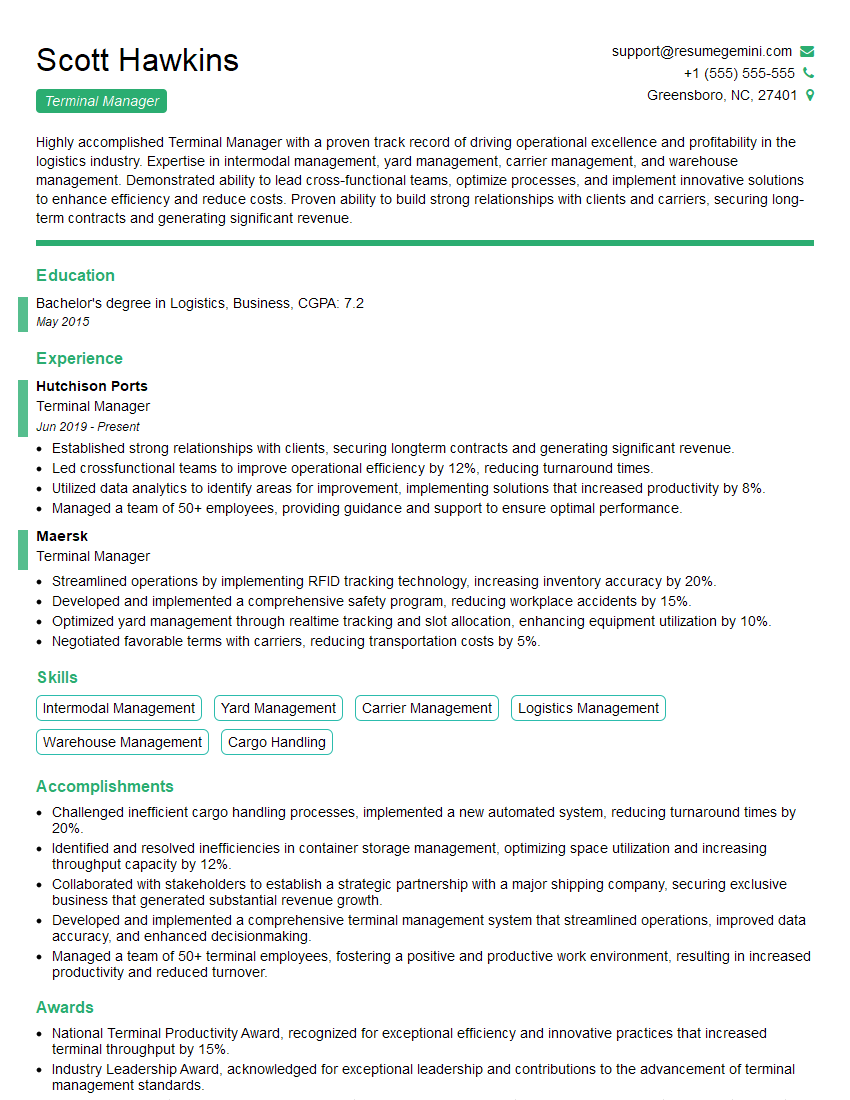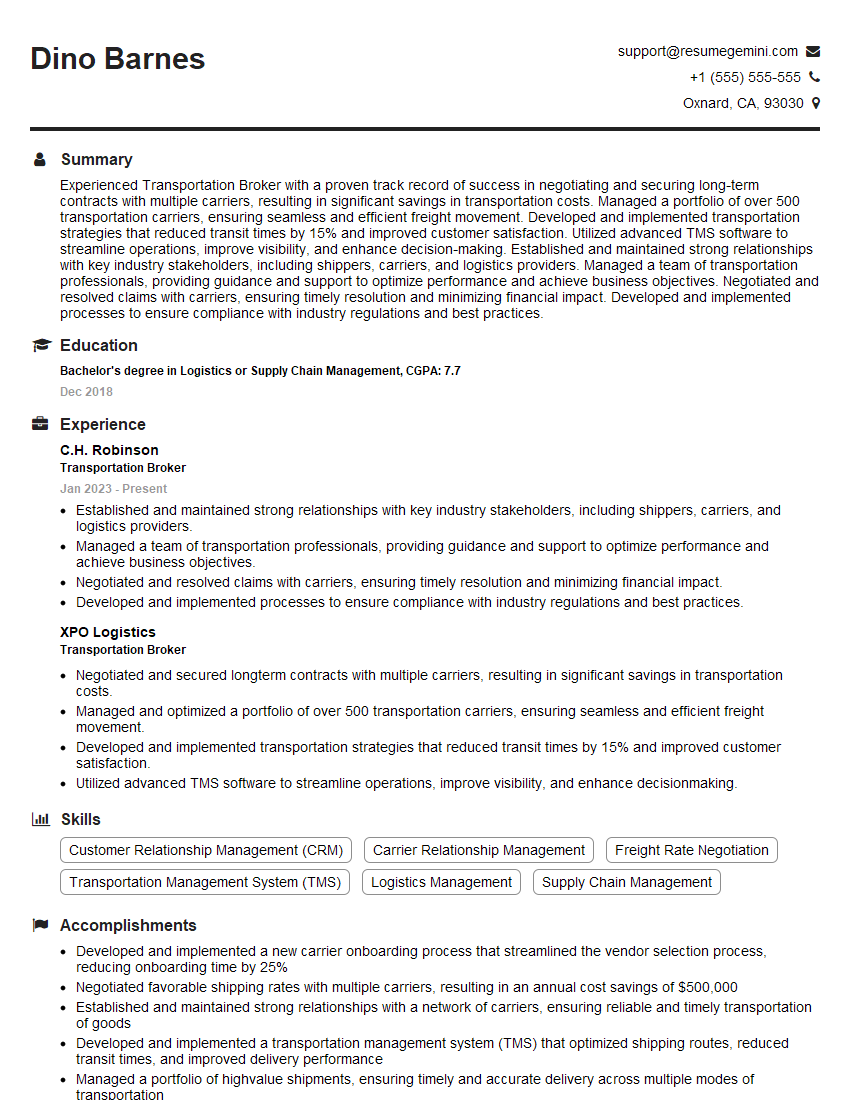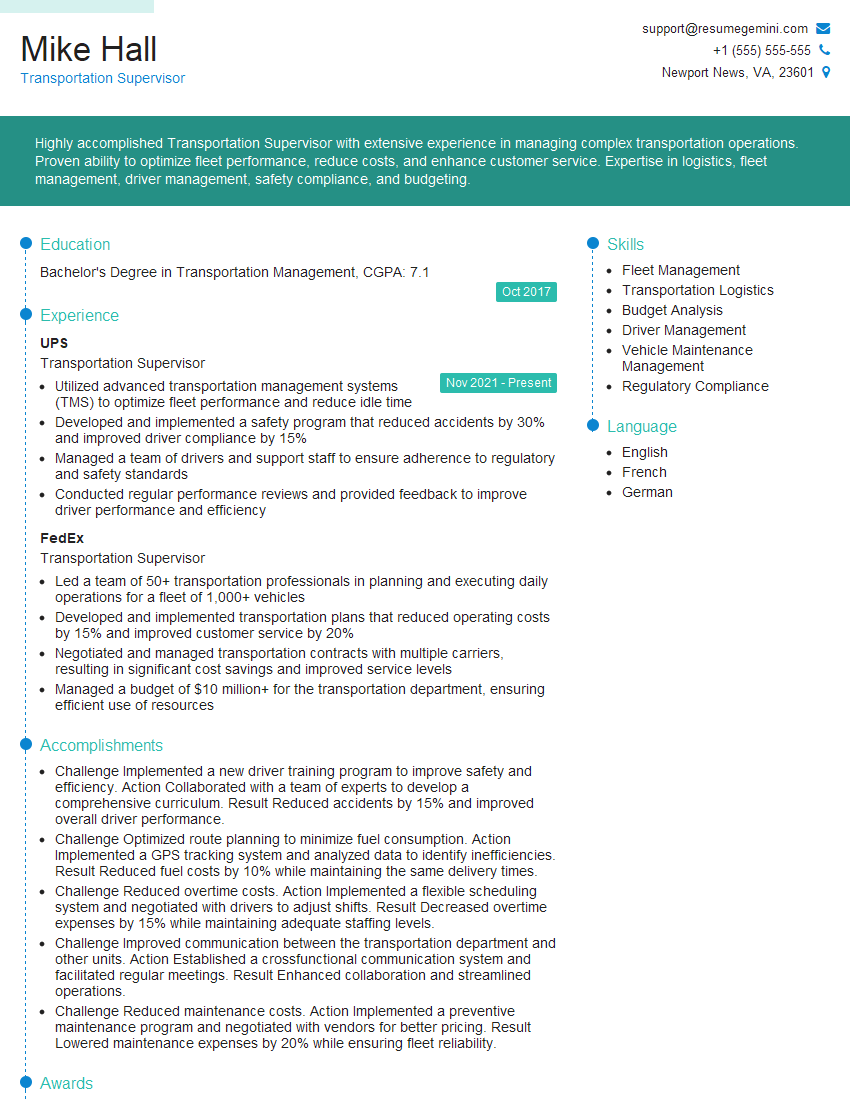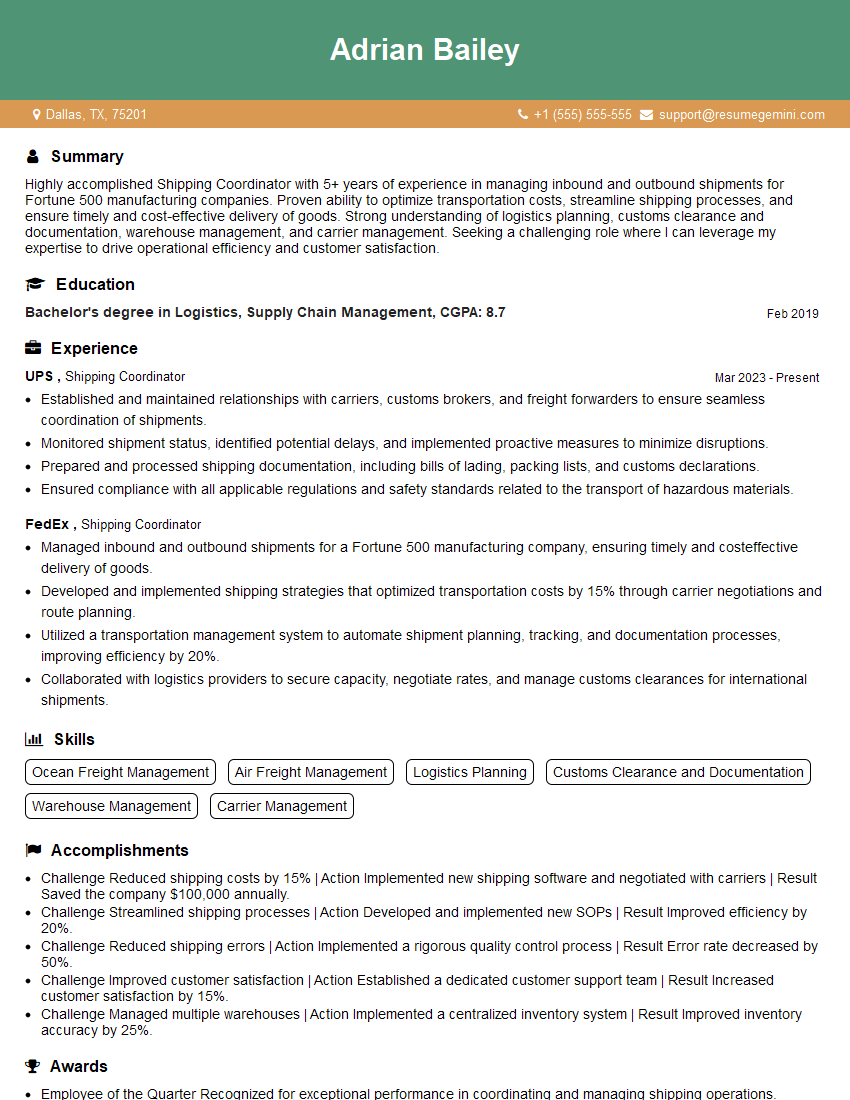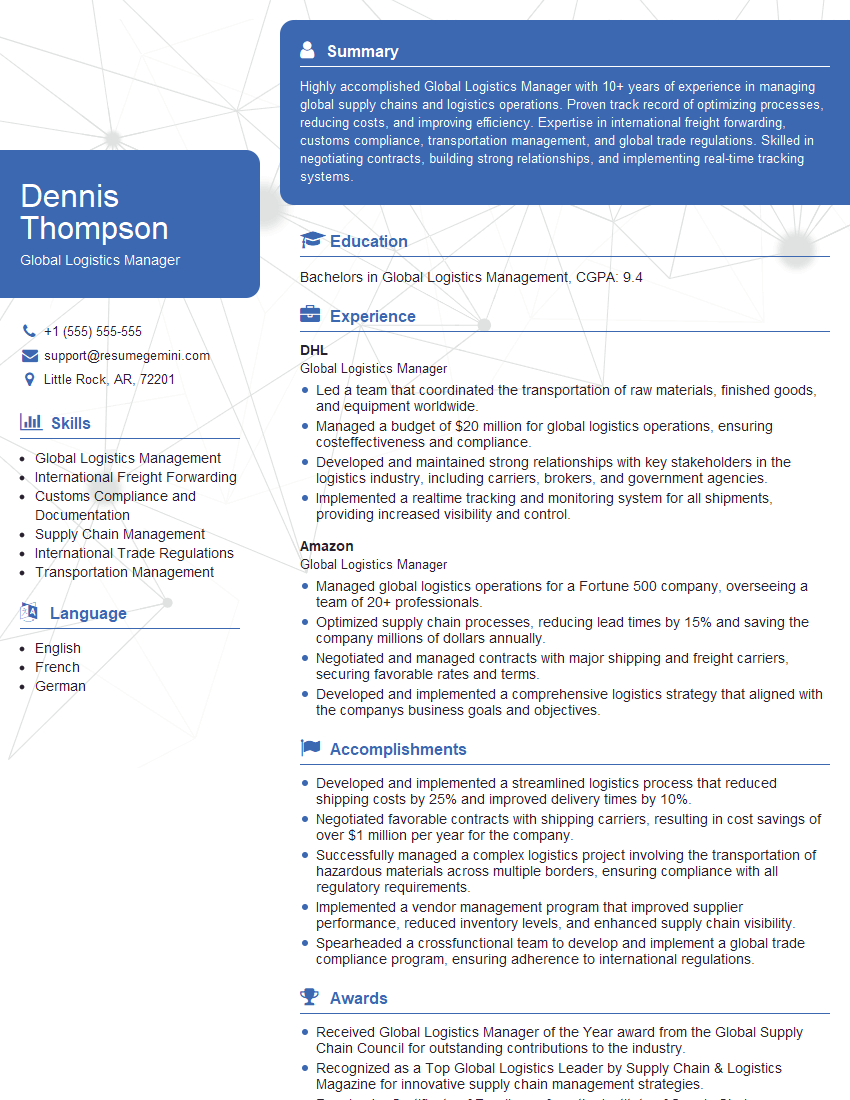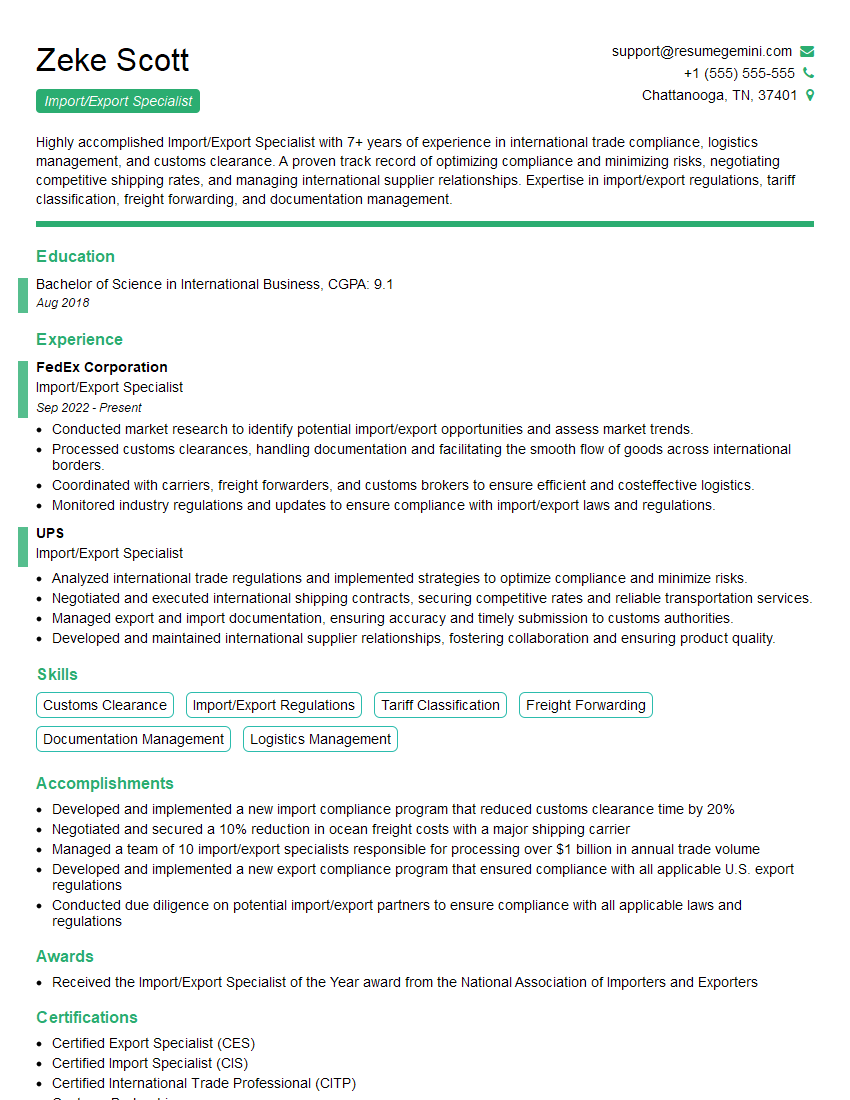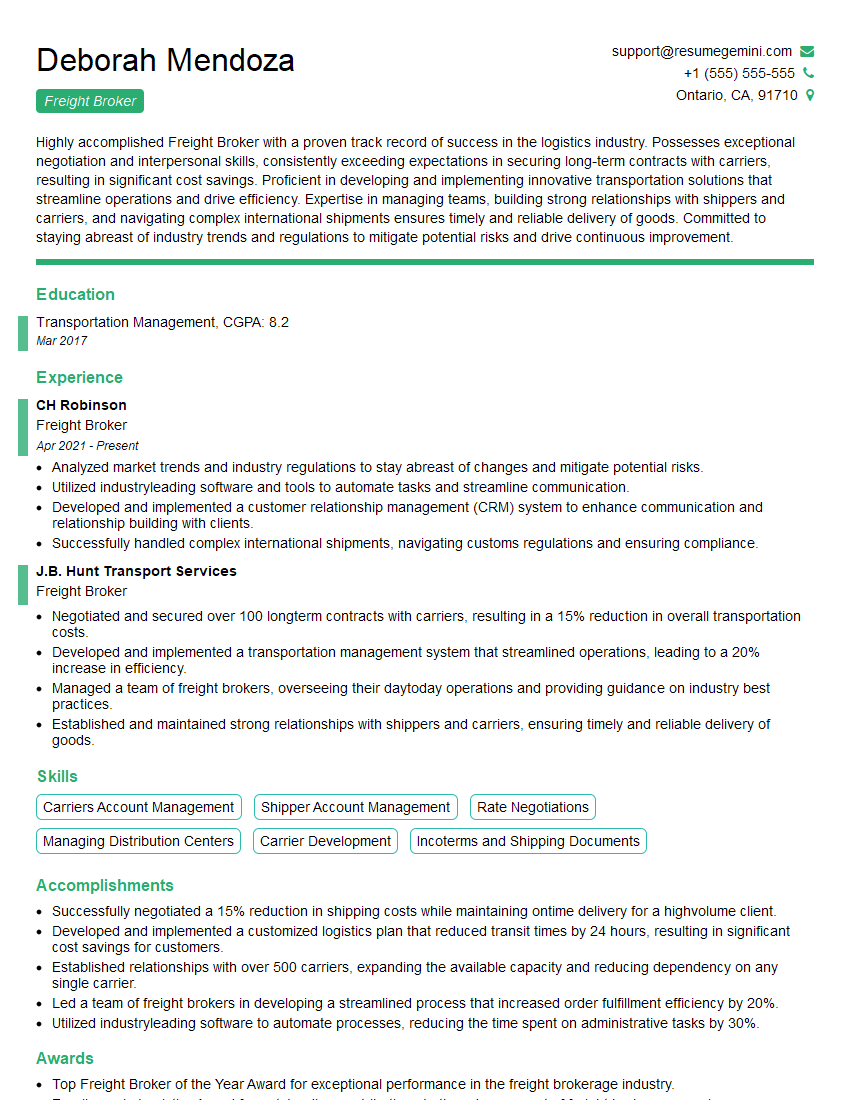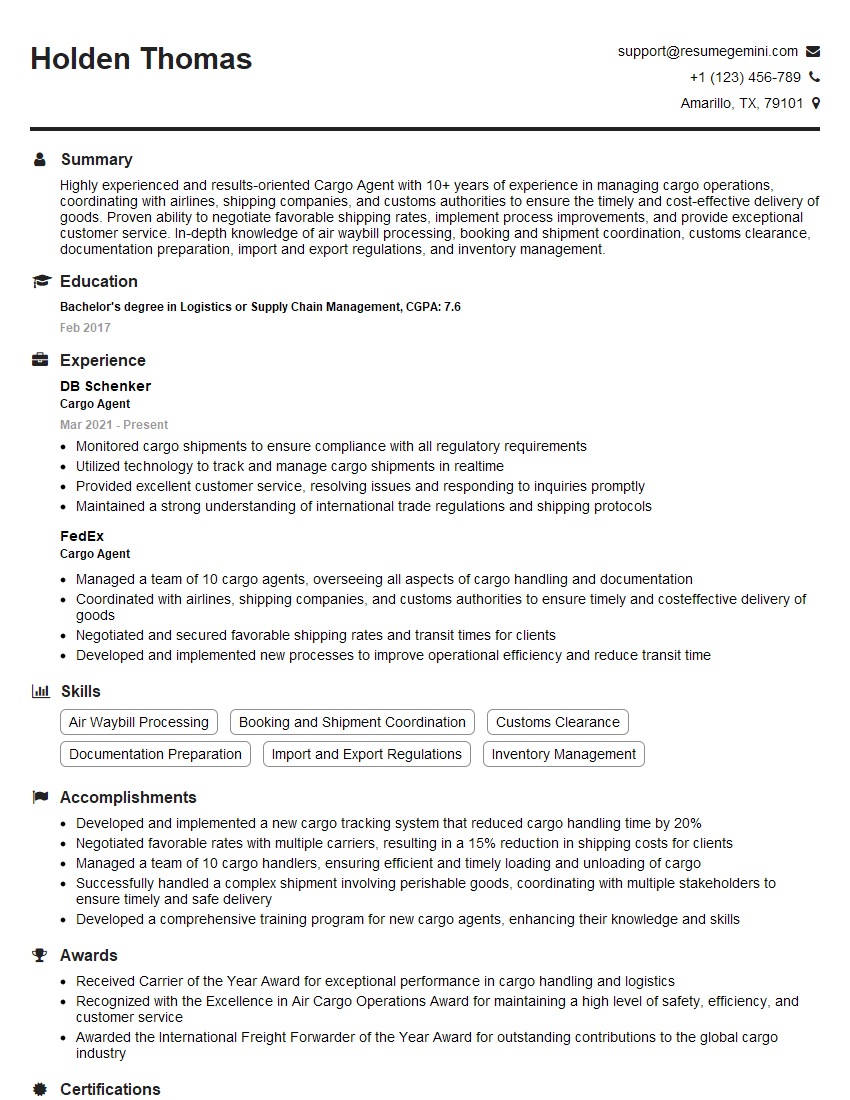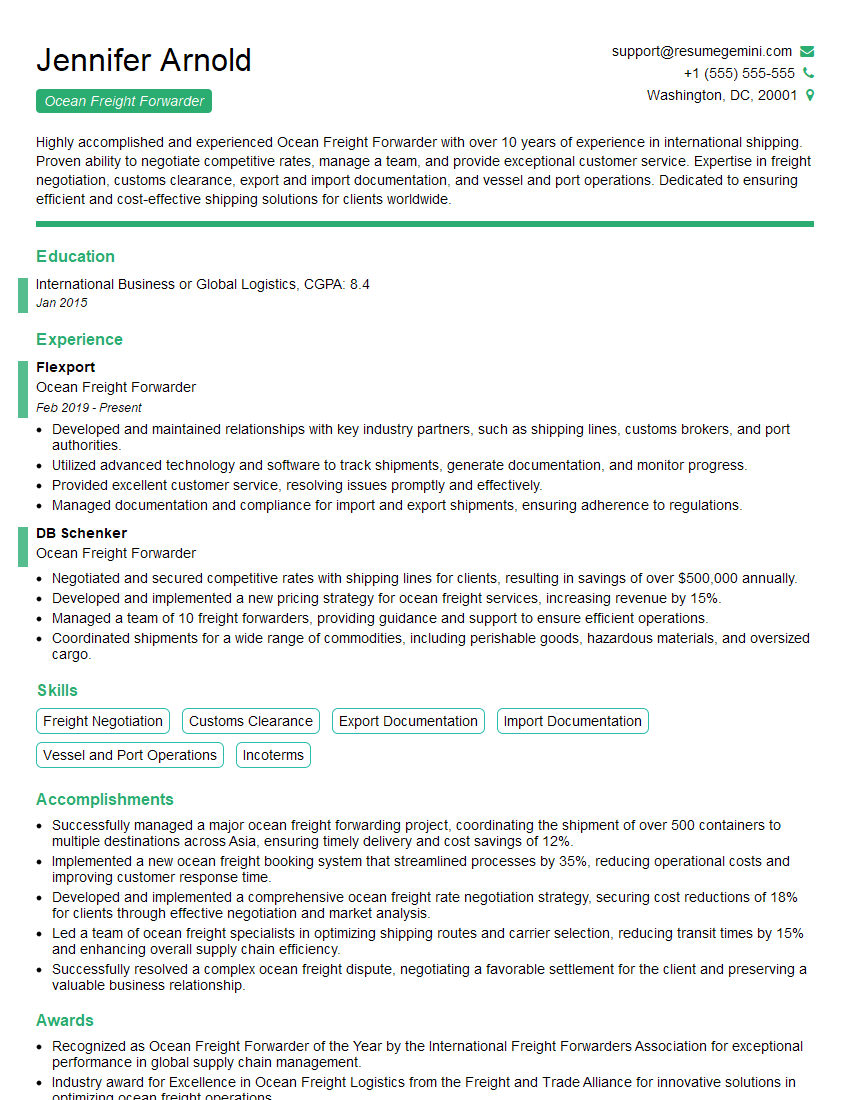Interviews are more than just a Q&A session—they’re a chance to prove your worth. This blog dives into essential Cargo Transport interview questions and expert tips to help you align your answers with what hiring managers are looking for. Start preparing to shine!
Questions Asked in Cargo Transport Interview
Q 1. Explain the Incoterms rules and their impact on cargo transport.
Incoterms rules, or International Commercial Terms, are a set of standardized trade terms published by the International Chamber of Commerce (ICC). They define the responsibilities of buyers and sellers in international trade transactions, specifically regarding delivery, costs, and risks associated with the shipment of goods. Understanding Incoterms is crucial for preventing disputes and ensuring smooth cargo transport.
- Impact on Cargo Transport: Incoterms directly affect who is responsible for various aspects of the shipment, including arranging transportation, paying freight costs, insurance, and managing risks during transit. For example, using
CIF (Cost, Insurance, and Freight)means the seller covers costs and insurance up to the port of destination, whileFOB (Free On Board)puts the responsibility for shipment costs and risks on the buyer once the goods are loaded onto the vessel. - Example: Consider a shipment from China to the US. If the Incoterms are
FOB Shanghai, the seller is responsible for delivering the goods to the port in Shanghai. From there, the buyer is responsible for the freight, insurance, and customs clearance in the US. If it wasCIF New York, the seller handles all of this up to the arrival in New York. - Practical Application: Choosing the right Incoterms is critical during contract negotiation. They ensure both parties are clear on their obligations, minimizing misunderstandings and disputes. A poorly chosen Incoterm can lead to significant financial implications and delays.
Q 2. Describe your experience with different modes of transportation (sea, air, land).
My experience spans all major modes of transport – sea, air, and land. Each has its unique advantages and challenges.
- Sea Freight: I’ve extensively managed large-scale sea freight operations, coordinating shipments across various ocean routes. This includes handling containerized cargo, bulk shipments, and specialized vessels. Sea freight is cost-effective for high-volume, less time-sensitive goods, but it’s slower than air freight.
- Air Freight: I have experience with air freight, primarily for time-sensitive or high-value goods. This often involves coordinating with multiple airlines and handling delicate or perishable items requiring specialized handling. Air freight is fast but considerably more expensive than sea freight.
- Land Freight: My experience includes managing land transport, including trucking and rail. This often involves coordinating with multiple trucking companies, optimizing routes for efficiency, and managing potential border crossing complexities. Land transport offers flexibility in reaching destinations not directly accessible by sea or air, but can be susceptible to traffic delays and varying road conditions.
I’ve successfully navigated the logistical challenges of each mode, optimizing transport choices based on factors such as cost, time constraints, cargo characteristics, and destination accessibility.
Q 3. How do you handle customs clearance procedures?
Customs clearance is a critical step in international cargo transport. My approach involves meticulous preparation and proactive communication.
- Documentation: I ensure all necessary documentation, such as commercial invoices, packing lists, bills of lading, certificates of origin, and any other required permits, are accurately completed and readily available. Any inconsistencies can lead to significant delays.
- Classification: Accurate classification of goods under the Harmonized System (HS) code is crucial for determining the correct duties and taxes. Mistakes here can lead to fines and delays.
- Brokerage: While I have the knowledge to navigate customs procedures myself, I often utilize customs brokers. They possess expert knowledge of local regulations and can expedite the process significantly, especially when dealing with complex or specialized goods.
- Communication: Maintaining clear communication with customs authorities, importers, and exporters is essential. Proactive reporting and addressing potential issues early minimize delays.
I have a strong track record of successfully clearing shipments through various customs agencies worldwide, minimizing delays and ensuring compliance with all regulations.
Q 4. What are the key challenges in international cargo transport?
International cargo transport faces numerous challenges. Some of the most significant include:
- Geopolitical Instability: Political unrest, trade wars, and sanctions can disrupt transportation routes and lead to delays or even complete shipment halts. We saw examples of this recently with the war in Ukraine.
- Supply Chain Disruptions: Global events, such as pandemics or natural disasters, can significantly disrupt supply chains, leading to shortages of shipping containers, port congestion, and delays.
- Customs Regulations and Compliance: Navigating varying customs regulations across countries can be complex and time-consuming, increasing the risk of delays, fines, and rejected shipments.
- Security Concerns: Protecting cargo from theft, damage, and terrorism is paramount. Security measures often add cost and complexity to the process.
- Rising Transportation Costs: Fuel costs, labor shortages, and increased demand can drive up transportation costs, impacting profitability.
Effective risk management and proactive planning are crucial to mitigating these challenges.
Q 5. Explain the process of tracking and tracing cargo shipments.
Tracking and tracing cargo shipments is vital for ensuring timely delivery and managing potential issues. My approach combines technology and human oversight.
- Technology: We utilize tracking systems that provide real-time location updates of shipments, allowing us to monitor their progress from origin to destination. This typically involves using container tracking numbers, bill of lading information, and carrier-provided tracking portals.
- Carrier Communication: Regular communication with carriers is essential to obtain updates, address potential delays, and proactively solve problems. This might involve phone calls, emails, or direct access to carrier systems.
- Proactive Monitoring: We proactively monitor shipments for potential delays or disruptions, allowing for timely interventions and minimizing impact on delivery schedules.
- Documentation: Maintaining accurate records of all tracking information is crucial for auditing, reporting, and resolving disputes.
Through this combined approach, we ensure clients are informed and any unforeseen issues are promptly addressed.
Q 6. How do you manage risks associated with cargo damage or loss?
Managing risks related to cargo damage or loss is critical. Our strategy involves a multi-layered approach:
- Insurance: We strongly advise clients to obtain adequate cargo insurance to cover potential losses or damages. The type and level of coverage depend on the specific cargo and the shipment’s risk profile.
- Proper Packaging: Ensuring goods are appropriately packaged for transit is crucial to minimizing damage. This includes using appropriate materials, secure fastening, and clear labeling.
- Careful Handling: Working with reliable and experienced carriers who prioritize proper handling of cargo is essential to reducing the risk of damage during transit.
- Documentation: Thorough documentation, including photographic evidence of cargo condition before and after shipment, is essential for insurance claims and dispute resolution.
- Contingency Planning: Having contingency plans in place for handling potential damage or loss minimizes disruptions and ensures timely resolution.
By implementing these measures, we strive to minimize risks and protect our clients’ interests.
Q 7. Describe your experience with different types of cargo handling equipment.
My experience includes working with a variety of cargo handling equipment across different modes of transportation.
- Container Cranes and Reach Stackers: Essential for loading and unloading containers in ports and terminals. I’ve coordinated their use in various port operations, ensuring efficient and safe handling of containers.
- Forklifts: Used extensively for moving pallets and other goods in warehouses and distribution centers. I’ve managed the use of forklifts to optimize warehouse operations and prevent damage.
- Conveyor Belts and Automated Systems: These are integral parts of modern warehousing and distribution systems. My experience includes overseeing the operation and maintenance of these systems, ensuring smooth cargo flow.
- Specialized Equipment: Depending on the cargo type, specialized equipment might be required, such as heavy-lift cranes for oversized cargo or temperature-controlled containers for perishable goods. I have experience coordinating the use of this specialized equipment, ensuring its safe and efficient operation.
Understanding the capabilities and limitations of different equipment is critical for efficient and safe cargo handling. Proper selection and utilization minimize damage, delays, and associated costs.
Q 8. How do you optimize transportation routes for efficiency?
Optimizing transportation routes for efficiency is crucial for minimizing costs and delivery times. It involves a multi-faceted approach, leveraging technology and logistical expertise. Think of it like planning the shortest, most efficient route on a road trip, but with much more complexity.
- Route Planning Software: We utilize sophisticated route planning software that considers factors like distance, traffic patterns, road conditions (including potential construction or weather delays), and delivery deadlines. These systems often use algorithms like Dijkstra’s algorithm or A* search to find optimal paths.
- Consolidation of Shipments: Combining smaller shipments into larger, consolidated loads reduces the number of trips needed, leading to significant fuel savings and increased efficiency. This is akin to packing a suitcase efficiently – you want to maximize space and minimize wasted room.
- Strategic Network Design: The entire network of warehouses, distribution centers, and transportation hubs needs to be strategically planned. This includes optimizing the location of facilities to minimize transport distances and leverage economies of scale. Imagine strategically placing distribution centers to serve various regions effectively.
- Real-time Monitoring and Adjustments: Continuous monitoring of shipments allows for real-time adjustments to routes in response to unexpected events like traffic congestion or accidents. This dynamic approach ensures optimal route efficiency even under changing conditions.
For example, in one project, we implemented a new route planning system that reduced our average delivery time by 15% and fuel consumption by 12% by consolidating smaller shipments and using real-time traffic data.
Q 9. What are your strategies for managing transportation costs?
Managing transportation costs requires a holistic strategy focusing on various levers. It’s like managing a household budget – careful planning and smart choices are crucial.
- Negotiating Favorable Rates with Carriers: Building strong relationships with carriers and leveraging volume discounts are essential. This involves detailed analysis of market rates and negotiating power.
- Optimizing Route Efficiency (as discussed above): Efficient routes directly translate to lower fuel costs, reduced driver downtime, and decreased wear and tear on vehicles.
- Load Optimization: Ensuring trucks are consistently at or near full capacity maximizes utilization and reduces per-unit transportation costs. This is similar to maximizing the use of space in a container to avoid wasted space.
- Mode Selection: Choosing the most cost-effective mode of transport – rail, road, sea, or air – depends on factors like distance, urgency, and cargo type. For example, rail is generally cheaper for long distances, while air freight is best for time-sensitive goods.
- Fuel Management: Implementing fuel-efficient driving practices, using fuel-efficient vehicles, and monitoring fuel consumption are vital for cost control. This is equivalent to conserving energy at home to reduce bills.
In a recent project, we reduced transportation costs by 18% by implementing a combination of route optimization, load consolidation, and aggressive carrier rate negotiation.
Q 10. How do you handle unexpected delays or disruptions in the supply chain?
Handling unexpected delays or disruptions is a critical skill in cargo transport. It requires proactive planning, robust contingency plans, and effective communication. Think of it as having a backup plan for your road trip in case of unexpected weather.
- Real-time Tracking and Monitoring: Closely monitoring shipments through GPS tracking and other technologies allows for early detection of potential delays. This gives us the ability to proactively address issues.
- Contingency Planning: Developing alternative transportation routes or modes of transport in case of unforeseen circumstances, such as road closures or port congestion.
- Strong Communication with Stakeholders: Maintaining open communication with clients, carriers, and other stakeholders ensures everyone is informed of delays and potential solutions. This minimizes disruptions and keeps everyone on the same page.
- Proactive Risk Management: Identifying potential risks in advance (e.g., seasonal weather patterns, political instability in certain regions) and creating strategies to mitigate those risks.
- Relationship Management: Strong relationships with reliable carriers and alternative transportation providers can provide backup options during emergencies.
For instance, during a recent severe storm, we successfully rerouted shipments using alternative routes and modes of transport, minimizing delays and preventing significant losses for our clients.
Q 11. Explain your experience with freight rate negotiation.
Freight rate negotiation is a crucial aspect of cost management in cargo transport. It requires a deep understanding of market dynamics, carrier capabilities, and negotiation strategies. It’s a dance, balancing your needs with the carrier’s willingness to transport your goods.
- Market Research: Thoroughly researching market rates for the specific route, cargo type, and volume is crucial for determining a fair price. Understanding seasonal fluctuations and market trends is key.
- Volume Negotiation: Offering higher volumes to carriers often leads to significant discounts. This is a classic example of economies of scale at play.
- Relationship Building: Developing long-term relationships with reliable carriers fosters trust and can lead to more favorable rates and terms.
- Strategic Partnerships: Forming strategic partnerships with multiple carriers allows for competition and better rates.
- Contract Negotiation: Negotiating detailed contracts with clear terms and conditions protects against unforeseen costs and disputes.
In my experience, I’ve successfully negotiated rates that were 10-15% below market average by leveraging our volume, building strong relationships with carriers, and strategically timing our negotiations.
Q 12. Describe your experience with warehouse management and inventory control.
Effective warehouse management and inventory control are essential for efficient operations and minimized storage costs. Think of it as running a well-organized and efficient grocery store.
- Warehouse Layout Optimization: Designing warehouse layouts to maximize space utilization and minimize handling time. This includes optimizing the placement of goods based on frequency of access.
- Inventory Tracking Systems: Implementing robust inventory tracking systems (e.g., barcoding, RFID) provides real-time visibility into stock levels, allowing for better forecasting and order fulfillment.
- Inventory Management Techniques: Utilizing inventory management techniques like FIFO (First-In, First-Out) or LIFO (Last-In, First-Out) optimizes inventory flow and reduces waste due to spoilage or obsolescence.
- Warehouse Management Systems (WMS): Utilizing WMS software automates many warehouse tasks, from receiving and put-away to picking and shipping, increasing efficiency and accuracy.
- Space Optimization: Implementing techniques for vertical storage and optimizing pallet stacking strategies to maximize space utilization.
In a previous role, I implemented a new WMS that reduced our inventory holding costs by 8% and improved order fulfillment accuracy by 12%.
Q 13. How do you ensure compliance with safety regulations in cargo transport?
Ensuring compliance with safety regulations is paramount in cargo transport. It not only protects the environment and people but also avoids costly fines and legal issues. It’s like following the traffic rules while driving – a necessity for safe and smooth operations.
- Driver Training and Certification: Ensuring drivers are properly trained and possess the necessary certifications to operate vehicles and handle cargo safely. This involves regular safety training and refresher courses.
- Vehicle Maintenance and Inspections: Regular vehicle maintenance and inspections are crucial for preventing accidents and ensuring compliance with emission standards. This is like getting your car regularly serviced.
- Cargo Securement: Proper cargo securement techniques are vital to prevent shifting or damage during transit. This involves using appropriate straps, tie-downs, and other securement devices.
- Hazardous Material Handling: Strict adherence to regulations for handling and transporting hazardous materials is non-negotiable. This includes proper labeling, packaging, and documentation.
- Compliance Audits: Regular audits to ensure compliance with all relevant safety regulations, including local, national, and international standards.
We have a robust safety program that includes regular training, vehicle inspections, and a zero-tolerance policy for safety violations. This has resulted in a significant reduction in accidents and non-compliance issues.
Q 14. What is your experience with using Transportation Management Systems (TMS)?
Transportation Management Systems (TMS) are indispensable tools for optimizing cargo transport operations. They’re like having a central control panel for your entire transportation network.
- Route Optimization: TMS software significantly improves route planning, taking into account real-time data such as traffic, weather, and delivery deadlines.
- Freight Rate Management: TMS helps in negotiating better rates with carriers by providing data on market rates and historical cost analysis.
- Document Management: TMS streamlines document management, such as bills of lading, invoices, and customs documentation.
- Inventory Management Integration: Many TMS solutions integrate with warehouse management systems (WMS), providing end-to-end visibility of the supply chain.
- Reporting and Analytics: TMS provides comprehensive reporting and analytics capabilities, providing valuable insights into operational efficiency and cost management.
I have extensive experience using various TMS platforms, including Oracle Transportation Management and SAP Transportation Management. In past roles, I have successfully implemented and customized TMS software, leading to significant improvements in efficiency and cost savings.
Q 15. Explain your experience with various documentation required for cargo transport.
Cargo transport involves a complex web of documentation ensuring smooth and legal operations. My experience spans a wide range, from the fundamental shipping documents to specialized certifications. Let’s break it down:
Bill of Lading (B/L): This is the most crucial document, acting as a contract of carriage, receipt for goods, and title to the goods. I’ve handled countless B/Ls, ensuring accuracy in details like cargo description, quantity, and destination, crucial for avoiding disputes and delays.
Commercial Invoice: This document details the transaction between the buyer and seller, including price, payment terms, and product description. I ensure its alignment with the B/L to avoid discrepancies in customs clearance.
Packing List: Providing a detailed inventory of the contents of each package, this aids in cargo tracking and damage assessment. I’ve used this document in several instances to expedite claims processes with insurance providers when goods were damaged in transit.
Certificate of Origin (COO): Verifying the origin of goods, this document is crucial for tariffs and trade regulations. I’ve worked with COOs in international shipments, meticulously verifying their accuracy to facilitate smooth customs clearance.
Dangerous Goods Declaration: For shipments containing hazardous materials (IMDG Code for sea freight, IATA DGR for air freight), this document is paramount. I’ve been trained to handle these meticulously, ensuring compliance with stringent safety regulations. A single error can cause severe delays or even accidents.
Customs Documents: These vary greatly depending on the countries involved, but consistently include import/export declarations, invoices, and potentially other specific forms. I have developed expertise in navigating the varied regulations, reducing delays by ensuring accurate and timely filing.
My experience encompasses both import and export documentation across various modes of transport – sea, air, and road – ensuring consistent compliance with international and national regulations.
Career Expert Tips:
- Ace those interviews! Prepare effectively by reviewing the Top 50 Most Common Interview Questions on ResumeGemini.
- Navigate your job search with confidence! Explore a wide range of Career Tips on ResumeGemini. Learn about common challenges and recommendations to overcome them.
- Craft the perfect resume! Master the Art of Resume Writing with ResumeGemini’s guide. Showcase your unique qualifications and achievements effectively.
- Don’t miss out on holiday savings! Build your dream resume with ResumeGemini’s ATS optimized templates.
Q 16. How do you handle customer complaints and resolve conflicts?
Handling customer complaints and resolving conflicts requires a calm, empathetic approach and a focus on finding mutually agreeable solutions. My strategy involves:
Active Listening: I begin by fully understanding the customer’s perspective, allowing them to express their concerns without interruption. This shows respect and builds trust.
Empathy and Validation: Even if the complaint is not entirely justified, acknowledging the customer’s frustration and validating their feelings is crucial. A phrase like, “I understand your frustration; this is certainly not the experience we want you to have,” can go a long way.
Investigation and Fact-Finding: I thoroughly investigate the situation, gathering all relevant information from our operational records and possibly communicating with other teams involved.
Solution Proposal: Based on my findings, I propose a concrete solution, whether it’s a refund, compensation, a revised delivery schedule, or an explanation of what happened. I always strive for a solution that is fair to both the customer and the company.
Follow-up: I follow up with the customer to ensure they are satisfied with the resolution. This demonstrates commitment to customer service and helps build lasting relationships.
For example, once a customer experienced a significant delay in their shipment due to unforeseen port congestion. Instead of simply explaining the circumstances, I offered a partial refund and expedited delivery for their next shipment. This proactive approach transformed a negative experience into a positive one.
Q 17. What is your experience with dangerous goods handling and transportation?
Handling dangerous goods demands rigorous adherence to safety regulations and specialized training. My experience includes:
Classification and Labeling: I’m proficient in identifying dangerous goods according to the UN hazard classes and ensuring proper labeling and marking as per the IMDG Code (International Maritime Dangerous Goods Code) or IATA Dangerous Goods Regulations (DGR), depending on the mode of transport. Mislabeling can have catastrophic consequences.
Packaging and Segregation: I understand the importance of correct packaging to prevent leaks and spills, and the need for segregating incompatible goods to prevent dangerous reactions. We utilize specialized containers and employ strict procedures to ensure safe transport.
Documentation and Compliance: Preparing and verifying the necessary documentation, including the Dangerous Goods Declaration, is critical. This is not merely a formality; it’s a legal and safety requirement. Errors here can lead to significant penalties and safety risks.
Emergency Response: I am aware of the procedures to follow in case of accidents or incidents involving dangerous goods, including contacting emergency services and implementing containment measures.
One instance involved a shipment of flammable liquids. By strictly adhering to regulations, including using specialized containers and ensuring proper ventilation in the transport vehicle, we successfully delivered the cargo without incident.
Q 18. Describe your experience with cargo insurance and claims processes.
Cargo insurance is essential to mitigate financial risks associated with loss or damage during transit. My experience with cargo insurance and claims processes includes:
Policy Selection: I work with various insurance providers to select the most appropriate policy based on the cargo’s value, nature, and the mode of transport. Understanding the different coverage options (e.g., All Risks, Institute Cargo Clauses) is critical.
Documentation for Claims: In the event of a claim, I meticulously gather all necessary documentation, including the B/L, commercial invoice, packing list, photos of the damaged goods, survey reports, and the insurance policy. A comprehensive and well-organized claim package significantly increases the chances of a successful outcome.
Negotiation with Insurers: I’m experienced in negotiating with insurance providers to ensure fair and timely settlements. This involves clear communication, providing compelling evidence, and understanding the terms and conditions of the insurance policy.
Claim Tracking: I monitor the claim process closely and follow up with the insurer to expedite the settlement.
For example, when a shipment was damaged during a storm, I coordinated with the surveyor, gathered all necessary documents, and successfully negotiated a full settlement from the insurer within a reasonable timeframe.
Q 19. How do you stay updated on industry regulations and best practices?
Staying updated on industry regulations and best practices is crucial for maintaining compliance and optimizing operations. I employ several strategies:
Industry Publications and Journals: I regularly read trade publications like Journal of Commerce and industry-specific magazines to stay informed about new regulations, technological advancements, and best practices.
Professional Associations: Membership in relevant professional organizations (e.g., the Chartered Institute of Logistics and Transport) provides access to industry updates, conferences, and networking opportunities.
Government Websites and Regulatory Bodies: I regularly monitor websites of regulatory bodies (e.g., the IMO for maritime regulations, the FAA for air regulations) to stay abreast of legal requirements.
Webinars and Online Courses: I attend webinars and participate in online courses to enhance my knowledge of emerging trends and technologies in cargo transport.
Networking: Connecting with peers and experts through industry events and online platforms allows for the exchange of information and best practices.
This continuous learning ensures that my knowledge and expertise remain current, allowing me to navigate the ever-evolving landscape of cargo transport effectively and safely.
Q 20. How do you utilize technology to improve efficiency in cargo transport?
Technology plays a transformative role in enhancing efficiency in cargo transport. My experience encompasses:
Transportation Management Systems (TMS): I’m proficient in using TMS software for route optimization, shipment tracking, and fleet management, leading to cost savings and improved delivery times.
Example: Using a TMS to optimize routes based on real-time traffic data, resulting in a 15% reduction in fuel consumption.Global Positioning System (GPS) Tracking: Real-time monitoring of cargo location and condition via GPS trackers enhances security and allows for proactive intervention in case of delays or emergencies. This enables improved customer communication and efficient problem resolution.
Electronic Data Interchange (EDI): EDI facilitates seamless exchange of electronic documents between trading partners (e.g., B/Ls, invoices), streamlining administrative processes and reducing paperwork. This minimizes errors and speeds up transactions.
Blockchain Technology: Exploring the potential of blockchain for enhanced transparency and security in supply chains, ensuring the provenance and integrity of goods throughout the transport process.
Big Data Analytics: Utilizing data analytics to identify trends, predict potential delays, and optimize resource allocation for improved operational efficiency.
By strategically adopting and integrating these technologies, we’ve significantly improved our operational efficiency, reduced costs, and enhanced customer satisfaction.
Q 21. Explain your experience with different types of cargo containers.
My experience encompasses a wide range of cargo containers, each designed for specific needs. Here are some key types:
Dry Freight Containers: The standard, versatile containers used for general cargo. They come in various sizes (20ft, 40ft, 45ft) and are suitable for a wide range of non-perishable goods.
Refrigerated Containers (Reefer Containers): Equipped with refrigeration units to maintain a constant temperature, these are essential for transporting perishable goods like fruits, vegetables, and pharmaceuticals. I’ve handled many reefer shipments, monitoring temperature settings and ensuring the integrity of the cold chain.
Open-Top Containers: These containers have a removable roof, making them ideal for oversized or heavy cargo that cannot be loaded through the standard doors.
Flatrack Containers: These containers are flat without sides or a roof, allowing for the transport of extremely oversized or heavy cargo that may require specialized lifting equipment.
Tank Containers: Specialized for the transport of liquids, gases, and powders in bulk. These require specific safety protocols and careful handling, and I’ve received dedicated training on these protocols.
Special Purpose Containers: These are tailored to transport specific cargo, such as livestock, vehicles, or hazardous materials. Each requires its own specialized handling procedures.
Understanding the characteristics and suitability of each container type is crucial for ensuring the safe and efficient transport of diverse cargo.
Q 22. How do you manage the capacity planning for transportation?
Capacity planning in cargo transport is crucial for optimizing resource utilization and ensuring timely deliveries. It involves forecasting demand, analyzing available resources, and strategically allocating capacity to meet projected needs. This is a multi-faceted process.
Firstly, we analyze historical data on shipment volume, weight, and dimensions to predict future demand. We consider seasonal fluctuations, economic trends, and any anticipated changes in customer demand. For example, we might see a surge in shipments during peak holiday seasons or a drop during economic downturns. These forecasts are crucial to avoid over- or under-capacity.
Secondly, we assess our available resources: this includes the number of trucks, ships, trains, and warehousing space we have access to. We also consider the capacity limitations of each mode of transport. A particular truck might only carry a certain weight, and a ship might have constraints on container sizes. We also factor in the availability of skilled drivers and other personnel.
Finally, we allocate capacity to meet the projected demand, prioritizing shipments based on urgency, profitability, and customer agreements. This might involve negotiating contracts with additional carriers if our internal resources are insufficient or optimizing routes to maximize efficiency. For instance, if we anticipate a surge in shipments to a specific region, we may proactively secure additional transport capacity in advance to avoid potential delays and price increases.
Q 23. Describe your experience with different types of shipping documents (e.g., Bill of Lading).
My experience with shipping documents is extensive, encompassing a wide variety of documents crucial for international trade. The Bill of Lading (B/L) is a cornerstone document, acting as a contract of carriage between the shipper and the carrier. It details the goods being shipped, the terms of transport, and the responsibilities of each party. It’s essentially a receipt, a contract, and a document of title all in one.
- Bill of Lading (B/L): As mentioned, this is vital. I’ve worked with various types, including straight bills of lading (non-negotiable), order bills of lading (negotiable, often used with letters of credit), and sea waybills (simplified versions for less formal arrangements).
- Commercial Invoice: This describes the goods being shipped, their value, and the terms of sale between buyer and seller. It’s essential for customs purposes and accurate invoicing.
- Packing List: This document details the contents of each package, including quantity, description, and weight. This helps in verifying the shipment and quickly identifying any discrepancies.
- Certificate of Origin (COO): This document verifies the country of origin of the goods and is often required for customs procedures and preferential tariffs.
- Insurance Documents: This demonstrates that cargo is insured, protecting against loss or damage during transit.
Understanding and accurately completing these documents is critical for smooth cargo transportation and compliance with international regulations. A single error could lead to significant delays or even seizure of goods by customs.
Q 24. How do you handle port congestion and delays?
Port congestion and delays are unfortunately common challenges in cargo transport. To mitigate these, we utilize a multi-pronged approach.
- Proactive Monitoring: We constantly monitor port conditions using real-time data from various sources, including port authorities, shipping lines, and our own agents on the ground. This allows us to anticipate potential delays and adapt our strategies accordingly.
- Alternative Routing: If congestion is anticipated at a primary port, we have contingency plans in place to reroute shipments to alternative ports or utilize different modes of transportation, where feasible. For example, we might shift from ocean freight to air freight for time-sensitive shipments.
- Communication and Collaboration: We maintain close communication with our partners, including shipping lines, port authorities, and customs brokers. Open communication helps to identify problems early on and coordinate solutions effectively.
- Negotiation and Expediting: When delays are unavoidable, we work closely with port authorities and customs officials to expedite the clearance process, potentially using expediting services if needed.
- Contingency Planning: We prepare contingency plans for common disruptions such as labor strikes or severe weather, ensuring business continuity.
For example, during a recent port strike, we successfully rerouted several shipments through a neighboring port, minimizing the impact on our clients’ delivery timelines.
Q 25. What is your experience with import and export regulations?
Navigating import and export regulations is a critical aspect of my role. My experience covers a wide range of regulations, including customs duties, tariffs, quotas, and various country-specific requirements. I stay updated on these constantly evolving regulations by utilizing multiple resources.
- Regulatory Databases: We use specialized databases and software to access real-time updates on regulations. These tools often provide alerts for changes that might impact our operations.
- Industry Associations: Membership in relevant industry associations provides valuable insights into upcoming changes and potential challenges.
- Customs Brokers: We maintain strong working relationships with experienced customs brokers who provide expert advice on compliance and efficient customs clearance processes.
- Legal Counsel: When faced with complex or ambiguous regulatory issues, we consult with legal professionals specializing in international trade law.
Understanding and adhering to these regulations is not just about compliance; it’s about minimizing risks, ensuring efficient processing of shipments, and avoiding costly penalties. A thorough understanding of HS codes (Harmonized System codes for classifying goods) and the specific requirements of each country is paramount.
Q 26. How do you prioritize shipments based on urgency and importance?
Prioritizing shipments requires a systematic approach that balances urgency, importance, and resource constraints. We use a combination of factors to determine the priority level.
- Urgency: Shipments with tight deadlines or those that impact critical operations are given top priority. This often involves time-sensitive goods or projects with strict delivery dates.
- Importance: High-value goods, fragile items, or those crucial for essential services receive higher priority, even if their deadline is less immediate. We might prioritize a shipment of medical supplies over less critical goods, for instance.
- Profitability: While ethical considerations always come first, profitability is also a factor. Highly profitable shipments might receive higher priority if resources are limited.
- Customer Relationships: Long-term relationships with clients may influence the prioritization, especially in cases of competing deadlines.
We often use a weighted scoring system to rank shipments based on these factors, allowing for objective and transparent prioritization. This ensures that the most critical shipments receive the necessary attention and resources.
Q 27. What metrics do you use to measure the success of your transportation operations?
Measuring the success of our transportation operations involves tracking several key performance indicators (KPIs).
- On-Time Delivery Rate: This measures the percentage of shipments delivered on or before their scheduled arrival time. A high percentage indicates efficient operations and reliable service.
- Transit Time: This measures the average time it takes for a shipment to reach its destination. Reducing transit time improves efficiency and customer satisfaction.
- Cost per Shipment: This analyzes the cost-effectiveness of our operations, identifying areas for potential savings.
- Damage Rate: This tracks the percentage of shipments that arrive damaged, reflecting the effectiveness of our handling and packaging procedures.
- Customer Satisfaction: Gathering feedback from clients provides valuable insights into their experience with our services.
- Inventory Turnover: Measuring how quickly inventory moves through our system reflects efficiency in warehousing and logistics.
Regularly monitoring these KPIs allows us to identify trends, areas for improvement, and areas where our performance exceeds expectations. Data-driven decision-making is paramount in improving our efficiency and optimizing our operations.
Q 28. How do you manage a team in a fast-paced cargo transport environment?
Managing a team in a fast-paced cargo transport environment requires strong leadership, clear communication, and a collaborative approach.
- Clear Communication: Regular team meetings, updates, and transparent communication of goals and expectations are crucial. This minimizes confusion and ensures everyone is working towards shared objectives.
- Delegation and Empowerment: Effectively delegating tasks based on individual strengths and empowering team members to take ownership fosters accountability and increases efficiency.
- Conflict Resolution: Addressing conflicts promptly and fairly is vital. A positive and supportive team environment is conducive to high performance.
- Training and Development: Investing in training and development ensures that the team remains up-to-date with the latest technologies, regulations, and best practices.
- Motivation and Recognition: Recognizing and rewarding good performance is essential for maintaining team morale and motivation in a high-pressure environment. This could include bonuses, promotions or simply public acknowledgment of achievements.
In my experience, building trust and mutual respect among team members is essential for creating a high-performing team capable of handling the challenges of the fast-paced nature of cargo transport.
Key Topics to Learn for Your Cargo Transport Interview
- Logistics and Supply Chain Management: Understanding the entire process from origin to destination, including documentation, warehousing, and inventory management.
- Modes of Transport: Familiarize yourself with the different modes (sea, air, rail, road) and their respective advantages, disadvantages, and cost implications. Consider practical application – how would you choose the optimal mode for a specific shipment?
- Cargo Handling and Security: Learn about best practices for loading, unloading, and securing cargo to prevent damage or theft. Think about real-world scenarios and how you’d address potential challenges.
- International Trade Regulations and Documentation: Understand import/export procedures, customs regulations, and the necessary documentation (e.g., Bill of Lading, Incoterms). Consider the practical application of navigating these complexities in different countries.
- Freight Forwarding and Customs Brokerage: Gain knowledge of the roles and responsibilities of these key players in the industry. How do they contribute to efficient cargo transport?
- Risk Management and Insurance: Understand the various risks associated with cargo transport (e.g., damage, loss, delays) and the role of insurance in mitigating these risks. How would you assess and mitigate risk for a high-value shipment?
- Technology in Cargo Transport: Explore the use of technology such as GPS tracking, TMS (Transportation Management Systems), and other software solutions to optimize efficiency and transparency.
- Sustainability and Environmental Considerations: Understand the environmental impact of cargo transport and the industry’s efforts towards sustainable practices.
Next Steps
Mastering cargo transport principles opens doors to a rewarding career with excellent growth potential. This field is constantly evolving, demanding professionals with strong problem-solving skills and a keen understanding of global logistics. To significantly enhance your job prospects, invest time in crafting an ATS-friendly resume that highlights your skills and experience effectively. ResumeGemini is a trusted resource to help you build a professional and impactful resume. We offer examples of resumes tailored to the Cargo Transport industry to guide you through the process.
Explore more articles
Users Rating of Our Blogs
Share Your Experience
We value your feedback! Please rate our content and share your thoughts (optional).
What Readers Say About Our Blog
Hello,
We found issues with your domain’s email setup that may be sending your messages to spam or blocking them completely. InboxShield Mini shows you how to fix it in minutes — no tech skills required.
Scan your domain now for details: https://inboxshield-mini.com/
— Adam @ InboxShield Mini
Reply STOP to unsubscribe
Hi, are you owner of interviewgemini.com? What if I told you I could help you find extra time in your schedule, reconnect with leads you didn’t even realize you missed, and bring in more “I want to work with you” conversations, without increasing your ad spend or hiring a full-time employee?
All with a flexible, budget-friendly service that could easily pay for itself. Sounds good?
Would it be nice to jump on a quick 10-minute call so I can show you exactly how we make this work?
Best,
Hapei
Marketing Director
Hey, I know you’re the owner of interviewgemini.com. I’ll be quick.
Fundraising for your business is tough and time-consuming. We make it easier by guaranteeing two private investor meetings each month, for six months. No demos, no pitch events – just direct introductions to active investors matched to your startup.
If youR17;re raising, this could help you build real momentum. Want me to send more info?
Hi, I represent an SEO company that specialises in getting you AI citations and higher rankings on Google. I’d like to offer you a 100% free SEO audit for your website. Would you be interested?
Hi, I represent an SEO company that specialises in getting you AI citations and higher rankings on Google. I’d like to offer you a 100% free SEO audit for your website. Would you be interested?
good






